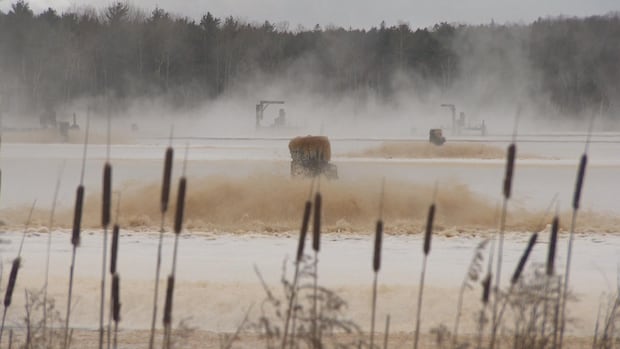Nova Scotia·NewA report by a provincially legislated panel on environmental racism contains 14 recommendations — including a call for a formal apology by the Nova Scotia government — and suggests reparations should also be considered, according to a draft document obtained by CBC News. Draft document has 14 recommendations, hints at reparationsListen to this articleEstimated 6 minutesThe audio version of this article is generated by text-to-speech, a technology based on artificial intelligence.Aerators churn up toxic mill waste in Boat Harbour in this file photo prior to the closure of the Northern Pulp mill in 2020. The former tidal estuary next to Pictou Landing First Nation was used to treat mill effluent for decades. (Steve Lawrence/CBC)A report by a provincially legislated panel on environmental racism contains 14 recommendations — including a call for a formal apology by the Nova Scotia government — and suggests reparations should also be considered, according to a draft document obtained by CBC News.Echoing throughout the report, which has yet to be made public, are calls for affected Mi’kmaw and African Nova Scotian communities to be empowered to work with the government rather than simply be consulted, “so that they themselves can hold government accountable to address the systemic issues that have been plaguing our communities.”While the report does not specify dollar amounts, it does say that “remediating and resolving” situations that exist due to environmental racism and taking steps to help ensure such practices do not continue “will require investment.”It also opens the door to the potential of reparations and notes that community land trusts could be one possible solution.“Resourcing those in community and community-based organizations that have had their health, social and economic wellbeing harmed by environmental racism should be considered,” it says.The 30-page draft was delivered to the provincial government in February 2024. But since last spring, multiple cabinet ministers have declined to detail its content, say whether it would be made public or confirm if they’d even read it.The Halifax city dump with Seaview African United Baptist Church and Africville houses in the background. Halifax expropriated land and demolished the historic Black community more than 50 years ago to make way for the A. Murray MacKay Bridge. (Nova Scotia Archives/Bob Brooks)Following pressure from Mi’kmaw chiefs and opposition MLAs, Environment Minister Tim Halman confirmed to reporters earlier this month that a meeting between cabinet ministers and panel members to discuss the recommendations and what to do with the report has been scheduled before Christmas.Although government officials have said the panel’s mandate did not specify that the document would be shared beyond internal circles, the report’s conclusion suggests panel members saw a role for a broader sharing of the information.“We look forward to the next steps of this work and hearing what Nova Scotians have to say about this report as a starting point,” the document says.The report’s 14 recommendations are:Establishing a first-of-its-kind community-led governance body, such as an environmental racism review board or an environmental racism and equity commission, armed with “decision-making authority” and a “working relationship” with the environment minister and the Office of Equity and Anti-Racism.Design a comprehensive community empowerment approach to provide direction to the governance body and the province on ways to address “past, present and future environmental racism.”Community empowerment initiatives should be led by existing organizations.A formal apology should be issued to Mi’kmaw and African Nova Scotian communities, “acknowledging that previous provincial decisions have had disproportional impacts on them as a result of environmental racism.” Public reporting on the progress and investments the province is making on addressing environmental racism.Adopt a formal definition of environmental racism for the purposes of ongoing legislative and policy changes.Recognize the 52 African Nova Scotian communities and impacts of environmental racism on these communities and their descendants.Consider changes to existing environmental approvals processes that better incorporate an environmental racism perspective. This could include “an adjudicative body focused on environmental racism to review projects requiring environmental approvals or other approvals associated with community and land use planning.”Create a process “integrated with existing annual provincial budgeting” to fund initiatives deemed a priority by governance bodies.Develop a multi-year financial investment to fund priorities identified by the governance body.Identify community groups focused on equity and the impacts of environmental racism to lead in advancing initiatives prioritized by the governance body.Prioritize and resource the assessment of previous work on environmental racism.Work with community to prioritize potential solutions.Amend the Environmental Goals and Climate Change Reduction Act to codify the panel’s recommendations into law.The call for the report was the result of an NDP amendment to major environmental legislation the Progressive Conservative government passed in 2021.Environment Minister Tim Halman. (Robert Short/CBC)Following a speech Wednesday at a Halifax Chamber of Commerce luncheon, Halman would not say whether the government is prepared to accept any of the report’s recommendations. “There has been historic discrimination against some groups in this province and certainly that’s why we have an Office of Equity and Anti-Racism to address that,” he said.Halman said government would have more to say following the meeting with members of the panel.The panel report includes a chapter on the history of environmental racism in Nova Scotia, and details examples such as the relocation of the community of Membertou, the construction of a dump in Shelburne near a predominantly African Nova Scotian community, the pollution of Boat Harbour by pulp mill waste near Pictou Landing First Nation and the razing of the historic Black community of Africville in Halifax’s north end to make way for the A. Murray MacKay Bridge.“These stories tell us about the structurally embedded barriers in government policy, legislation, regulations and processes and speak to the need for responding structures dedicated to dealing with the complexity of these issues,” the report says.It goes on to say that those structures should have “strong community membership and be representative of those who have lived experience with systemic racism generally and environmental racism specifically.”Another chapter focuses on community engagement.In it, the panel calls for a “trauma-informed approach” to establish “robust, mutually beneficial relationships and partnerships with community.”“This is about community empowerment. The work will need to proceed at the speed that Mi’kmaq and [African Nova Scotian] communities are willing to go. Building the necessary trust and authenticity around this work will take time, but it is the only way that there will be meaningful change.”Premier Tim Houston’s government has been criticized for a lack of consultation around legislation aimed at enhancing natural resource development and aggressive efforts to spur more projects in the interest of increased economic development.The report suggests a definition of environmental racism should include:The “disproportionate location and greater exposure of Indigenous and racialized communities to contamination and pollution from industries.”The “lack of political power these communities have for resisting the placement of industrial polluters in their communities.”“Implementation of policies that sanction the harmful and, in many cases, life-threatening presence of poisons in these communities.”“Disproportionate negative impacts of environmental policies that result in differential rates of cleanup of environmental contaminants in these communities.”“The history of excluding Indigenous and racialized communities from mainstream environmental groups, decision-making boards, commissions, and regulatory bodies.”MORE TOP STORIESABOUT THE AUTHORElizabeth Chiu is a short documentary producer in Nova Scotia. She’s passionate about engaging with the community to share their stories. Send your story idea to elizabeth.chiu@cbc.ca.
Report calls on N.S. to apologize to Mikmaw, Black communities for environmental racism












